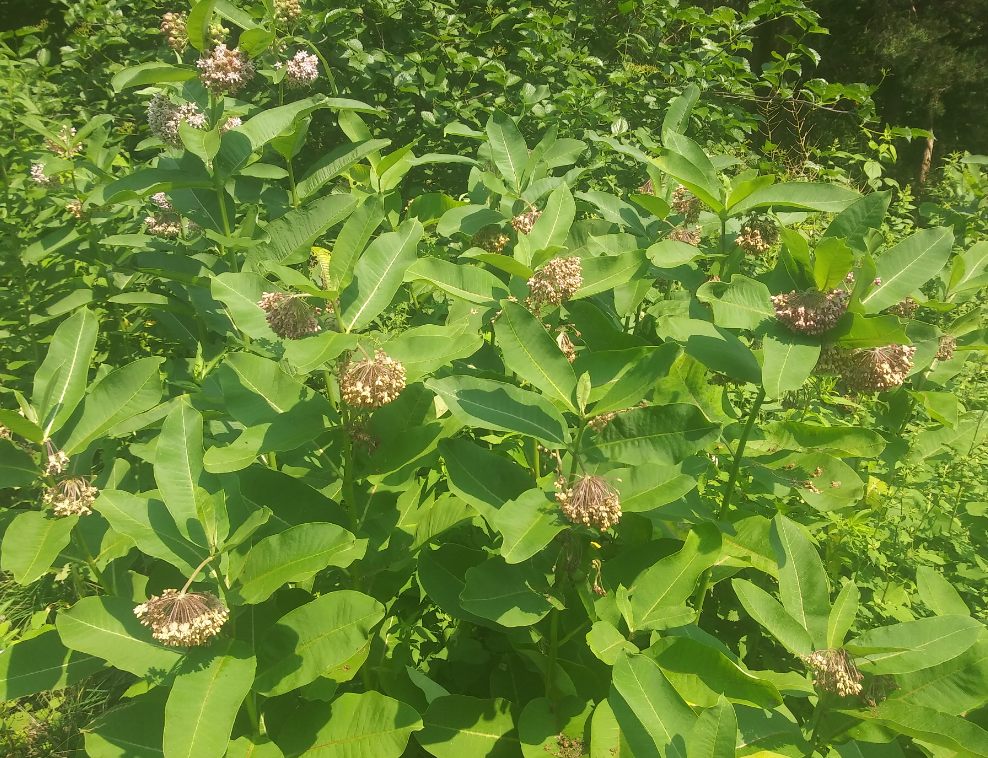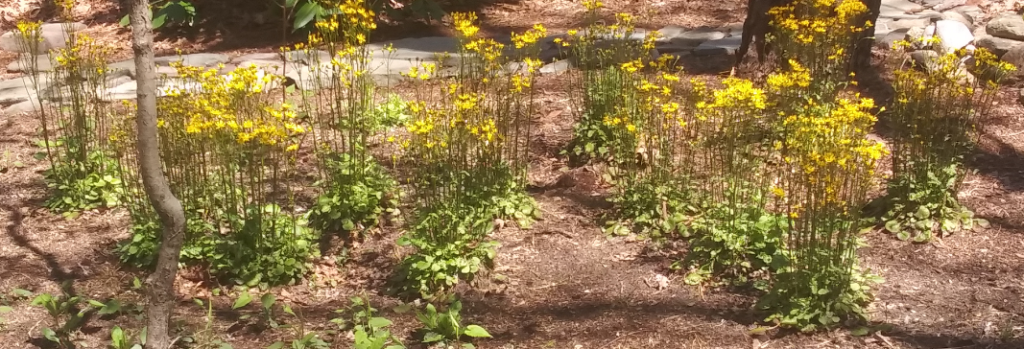For years I have been trying to find a copy of “Shrubs of the Northern New England Forest”, by Michael L. Cline. It was recommended by a plant enthusiast I met at Wells Reserve at Laudholm, some 8 or 9 years ago. I looked for it at the usual online vendors such as Amazon and eBay, knowing that it was likely out of print. Going through some old paperwork I found the original note, reminding me to give this another go. I was sad to find out that the author had passed a few years back – https://www.tinmountain.org/wp-content/uploads/Michael-L-Cline.pdf – he seemed like quite the tree guy, and I wish I could have had a chance to meet him. While he is gone, his legacy lives on in the Tin Mountain Conservation Center in New Hampshire. Hats off to you, sir.
OK, I am 9 days into prepping the straw bales, on track to start planting in early May. This is my second year of doing this, adding 2 more bales to a total of eight this time around. There is a bit more planning involved, but the benefits are a higher yield, and not having to contend with the soil which seems to be 50% rock. Great for native plants, not so much for tomatoes and cucumber plants. I am hoping the lessons learned from last year will get even better results. I packed in plants too tightly, did not provide enough support wires and did not anticipate the bales deteriorating and shrinking, leading to structural collapse. All to be addressed this time around!
While I am anticipating some visitors for the fruits later in the season, I was not ready to host friends looking for a hot bale

Posted in Uncategorized | Leave a Comment »
OK, Sanguinaria canadensis might not be the shortest blooming plant in my woodland garden, but it is probably a very close second to Jeffersonia diphylla (twinleaf) – whose blooms often don’t make it to the end of the day. The bloodroot flowers bloom for a few days, tops. The petals drop with the slightest rain or wind. But often that is all that is necessary to get the job done – bees are already out this time of year to assist with pollination. The stem and flower are the first to emerge, and often the leaves are still unfurling (like in the picture below) when the flowers are starting to go.
I have had these for almost a decade now, and they are doing well, although I might have to rethink that vision of expansive beds of bloodroot. The singular plants from a decade ago are now small clusters, confirming that this plant spreads by rhizomes. And I have found plants in random places in the yard, indicating that some seeds germinated as well. But nature does not care much for the human clock and bloodroot will do its thing at its own pace.
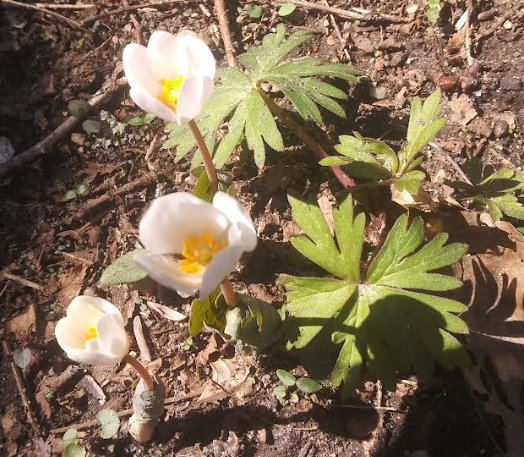
Original post: http://www.capecodwoodlandgarden.com/2013/04/22/sanguinaria-canadensis-bloodroot/
Posted in Uncategorized | 1 Comment »
I’ve had these in the yard for a year or two now, and I am happy I added them as they are quite versatile, doing well in all sorts of woodland conditions as long as there is some dappled shade. While they seem to be quite dainty, they showed some resilience when an eager delivery man decided to take a shortcut through this part of the yard and was walking all over them. I was surprised to see the stems bend and bounce back almost immediately.
At this time of year they are one of the earlier blooming plants but you would not know it unless you get up close. The flowers of the buttercup family plant are small and grouped in follicles. The leaves are light green and quite attractive. What I like best are the leggy one to two feet stems that are a light tan color.
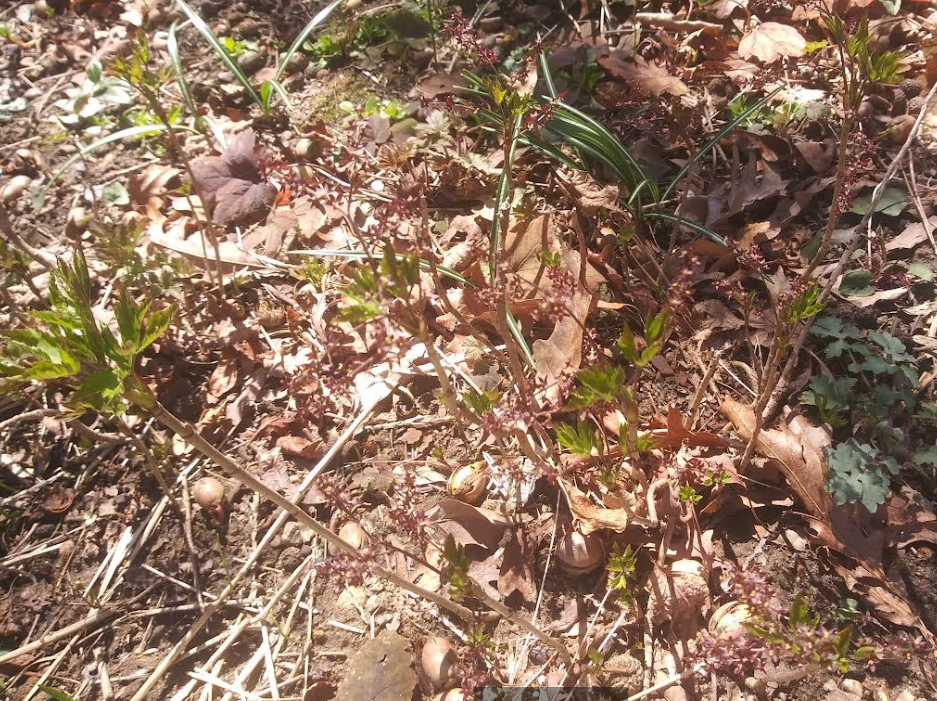
The common name refers to the bright colored roots, which have been used in dyes and have antibiotic, immuno-stimulant, anticonvulsant, sedative, hypotensive, uterotonic, and choleretic properties. Berberine is the main alkaloid found in the plant and it has medicinal and supplement properties. In large quantities it can be toxic however. Either way, I won’t be digging up these beautiful open-structured shrubs any time soon – I expect them to gain some height up to 2-3 feet and spread from suckers. This plant plays well with others and the leaves provide a great accent with other groundcovers like foamflower.
Posted in Uncategorized | Leave a Comment »
In my case, I have been doing exactly that for a number of years. Many years ago I found if difficult to even find these plants. Common milkweed (Asclepias syriaca) was still being sprayed and removed, and you could not yet find swamp milkweed (Asclepias incarnata) in the garden centers. Dial forward a few years and now they are all the rage. Well, they should be. You may not find common milkweed in the garden centers quite yet, but you are more likely to find a few plants with seed pods nowadays, and if you go online you should have no problem. I am not going to go into the plant descriptions as I did that a few years ago already, but I want to make a passionate plea to have you add milkweed plants to your garden mix. They are not only crucial to the survival of the monarch butterfly, but there are hundreds of other insects, hummingbirds, and small herbivores that need this group of plants to stick around. And we should be generous with the space we allow the milkweeds. Volume matters!. A dense thicket of milkweeds is better than a single plant here or there. Monarch caterpillars are easily spotted, and even though they may taste foul, enough of them still fall prey to hungry birds and other animals. Providing shelter is a good idea. OK, common milkweed can be a bit of a bully as it sprouts new plants from its roots in an ever growing circle, and it may end up in your lawn or some other designated area. Maybe you don’t need to mow as much, and can leave them be for a few months? Common milkweed are almost impossible to transplant – the root easily goes down 8-12 inches or more and if you are lucky to get enough root material, it will likely not be until next year you will see some fruit of your labor as 1 out of 20 will come back only. (I tried this too many times). Aside from common milkweed you should have good luck with Asclepias incarnata (swamp milkweed). This one is a lot more sedentary, but I find it does well only for a year or two, and then the original plant gives up. The key is getting new seedlings started on a continuous basis. I have some butterfly weed (Asclepias tuberosa) as well but propagation from seed has been spotty at best, and the mature plants like it sunny and dry. They don’t like to be shaded out, and as my yard is full of plants trying to outdo each other they are finding it difficult to maintain a foothold.
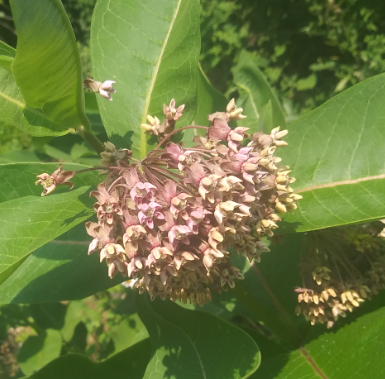
I have close to 200 milkweed plants in the sunniest part of the garden – 30% would be common milkweed, 65% marsh milkweed and the rest is butterfly weed and some whorled milkweed plants I started from a seed catalog. The yard is now also a monarch waystation site, although that by itself is not that hard to attain. (https://monarchwatch.org/)
Posted in Interesting | Leave a Comment »
This was an unusual plant to find at a plant store in October last year, but they were on sale and the basal leaves had a nice dark green color, so I took them home and planted them among the pines and black cherries. Much to my surprise they survived and thrived. The plant adds a whole other set of leaves and goes for a good foot or more of height to display the yellow flowers. The plants offer a beautiful yellow in a very early and otherwise fairly barren spring.
This member of the Asteraceae family is at home in swamps and wet woods but it does very well in a much drier environment. The plant can grow up to 3 feet tall. The picture above is from mid May.
Ragwort has a bad name, especially when it comes to pollen allergies. I am not sure how much pollen Packera aurea produces, but the plant is also mildly toxic and can cause skin allergies. It did not in my case – I handled these plants extensively, and I am someone who gets blisters at the mere mention of poison ivy and goldenrod. Just be aware that it could have an effect. This plant has quite a bit of medicinal application – it is used in diabetes and blood pressure remedies. It also gets honorable mention with treating menstrual pain, menopause symptoms, pain reduction, bleeding, and congestion.
Posted in Flora, Interesting, Plant bio | Leave a Comment »
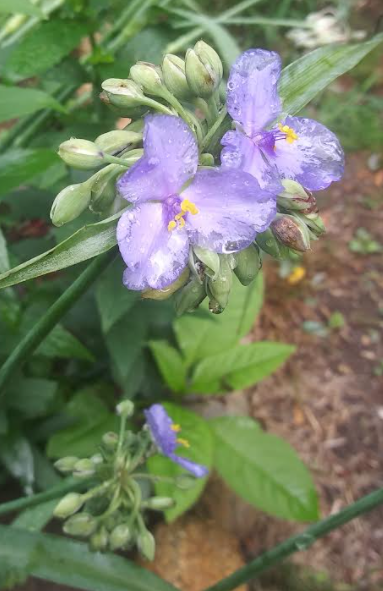
Tradescantia virginiana has done well in the woodland garden over the years, but the plants that get more sun have been prolific bloomers. Of course, with the wet weather we have been enduring they all are looking a bid sad and wet right now. I am planning on adding more spiderworts later this year, in a spot where they will get the additional light and space. While spiderworts generally tend to do fine in most locales, I noticed that the flowers are bigger and the stems are more upright compared to the ones nestled among the ferns and common wood asters. Those tend to flop and lean more on the surrounding plants, and the flowers get lost in the surrounding greenery, so they are less of a show case. They are exactly the same species, and from the same year and place of purchase. The only differentiator is sunlight and elbow room.
Posted in Flora, Interesting | Leave a Comment »
You can never start early enough. I am finding that I am always running out of time, or coming up against other constraints. I have some garden additions and changes that have been in the works for some time, or that I have started and abandoned due to other priorities. My latest interest is adding a straw bale garden. I have always had a smallish vegetable garden for some tomatoes, cucumbers, peppers and beans, but this has generally fallen below expectations. I have much more luck with native plants and would be ok with just doing that if not for having a fresh vegetable loving spouse, who loves to see some ROI from me spending countless hours outdoors. The straw bale concept has some immediate potential benefits, such as allowing a slightly earlier start to the growing season, and not having to prep the soil. Soils around here at the spit end of the ancient glaciers are mostly rock with some more rock in between. I have been digging those out of the same 10 square yard for years now and there is no end to it. They keep coming, seemingly pushed up from the deep on some conveyor belt. Anyway, the straw bale idea seems an ideal solution, even though getting the bales plus the 3 weeks of bale prep will likely be a painful and frustrating endeavor all of its own.
What else am I behind on? Let me check.
- I am building out a few walking paths – that is about a quarter done – I am waiting for slightly warmer days to clear out some prickly underbrush
- I have some 20 young trees (less than 2 feet tall) that need to be planted. They are overwintering in a leaf pile right now. I can’t get to the ideal locations until I extend the paths, and I can’t plant until I clear the brambles. There is a time constraint in that I want this done before the birds select their nesting area. And with the light expanding daily this is much sooner than you would think – I have already seen birds exploring the bird houses. I have until mid February at best
- The bird houses (12 right now) need to be inspected for rot, rehung in some cases, or cleaned (again). since the fall cleanup rodents of all sorts have moved in. While they don’t bother me the first and foremost intent is to provide nesting locations to the feathered friends. There may be some evictions, but to date I have let the critters move out on their own time. I realize full well that removing the bird houses in the fall would be a better option, but have I done that? Of course not.
- I have to move some Common wood aster plants. At a summer and fall height of 3-4 feet they are shading out some smaller blueberry bushes.
- I need to re-harden some of the existing paths – adding some gravel and border stones – this is likely not going to happen until the temperature hits mid 40s or even 50s
- I still have leaves everywhere, and I still need to bring down a few hundred square feet of perennial stalks. It should be first on this list, but I keep pushing it off into the future. I want this done before mid February as well…
- I took some seeds from perennials I want to expand – American bellflower (biennial in this area) and Carolina lupine in particular. They are in cold (fridge) storage right now and I will need to put together a little temporary greenhouse in early April to grow some more seedlings. I used to do more of this in years past but I am running out of room in the garden, so I need to be picky about what I want to add
- The wildlife pond is still a work in progress. I need to purchase the bedding material and some rocks. I am going to repurpose an ancient mini kettle pond that has been filled with building materials so many decades ago. I know I have peepers, frogs and toads already and my neighbor had some salamander sightings in his yard over the last couple of years. I just want to add a little wetland feature, but this has seemingly not been a real priority as I started this some 3 years ago.
If I can accomplish some of these tasks over the next month, things are looking up. The perennial woodland garden is mostly mature and needs very little attention during the growing season. I may even invest in a deck chair or two and enjoy it, or think about my list
Posted in Uncategorized | Leave a Comment »
This is a topic I have talked about in the past, but I was reminded of invasive species when I encountered this setup to evaluate the control/eradication of Japanese knotweed along the CCRT path in Eastham. the contraption consists of nothing more than a wire mesh laid over knotweed roots. I guess the idea is that the shoots will be cut at the base by the wire, depriving the root base of nutrients. We’ll see if it works – the plants looked pretty healthy to me, but their circumference had not made it to decapitation level yet… Japanese knotweed is a real scourge not only on Cape Cod but anywhere it is taking foothold. I hope we can find a non-toxic way of getting rid of it, or at least control it. Another way to deal with (some) invasive plants is eating them. NEWFS (New England Wild Flower Society) had a webinar on this recently (“Managing Invasives Through Eating: A Conservation Diner’s Guide”) and lately I have seen more and more posts on the internet of people doing exactly that. That is definitely something I want to explore further – although – how much knotweed do you want to eat? The supply seems never ending and if you are forced to eat too much of it, then well, it could turn out to be the next broccoli or pea… making children cry at the dinner table everywhere.
While eradicating Japanese knotweed from our landscape is beyond my capabilities, I have other non-native fish to fry right here in the woodland garden. When we bought the house and land many years ago, it came with some established plantings already. I have a 20 year old Butterfly bush, a handful of Morrow’s honeysuckle and some Burning bush plants. My rational mind says to take these all out, but there are also other things to consider – what is going to shield me from the neighbors or the street? The big bang approach does not work in my case, so I am taking a multi-year crowd-and-replace angle, which goes something like this: Plant native bushes around the 10 feet high and wide Morrow’s honeysuckle and over the course of a few years trim the target while allowing more space for the growing natives. Eventually take down the target. This is a long-term approach but it keeps shielding and shelter in place. I know it may make more sense to take care of this immediately, but I am not known for drastic measures, at least in the garden. This is the guy who prefers to dig and saw by hand power tools be damned
Some more suggestions can be found in this article, https://www.gardenista.com/posts/go-native-10-indigenous-alternatives-to-common-invasive-plants-garden-design/, although I am not a fan of all the suggestions – planting west coast natives on the east coast does not make sense to me. Native neighbors from east of the continental divide could work as the wildlife supported is the same or similar by-and-large, but west coast plants are part of a very different ecosystem altogether.
Posted in Flora, Interesting, Invasive, Rants & Raves | Leave a Comment »
Things change quickly in the woodland garden this time of year. The flowers of the wood poppy and Virginia bluebells have moved past their prime, and while those two are now moving on to seed production, this is the time for the spotted geranium to come into its own. The plants have self seeded over the years, but they are not as abundant as I would have hoped, at least not when compared to the self seeding prowess of wood poppy and wood aster. Plants don’t have a schedule to keep, and while our attention span is regulated and fleeting, they are happy to take all the time they need…

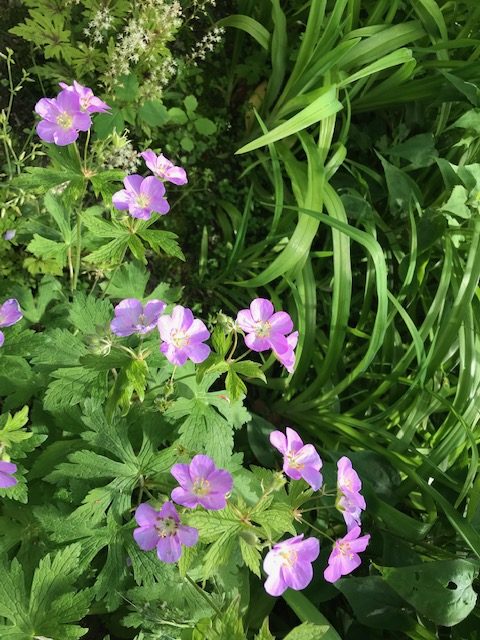
Posted in Uncategorized | Leave a Comment »
